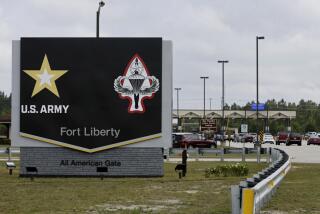Army May Buy 200,000 Acres to Expand Training at Ft. Irwin
- Share via
WASHINGTON — The Army, in a move designed to make its troop training exercises more realistic, is planning to buy 200,000 acres of land next to its National Training Center at Ft. Irwin, Calif., according to service officials.
The expansion of the 632,000-acre base would clear the way for larger maneuvers, including formations of as many as 10,000 troops and warplanes flying combat-support missions, at the training ground perched on the edge of Death Valley, about 110 miles northeast of Los Angeles.
“We need more land out there,” said Paul W. Johnson, deputy assistant secretary of the Army for installations and housing. “We want to get into brigade-size exercises and joint maneuvers (involving forces from different services). That’s what it’s all about.”
Johnson said the Army probably will seek congressional approval next year for the enlargement, which may cost about $29 million.
The increasing speeds of modern planes and tanks, and technology that enables Army units to see and strike opposing forces at longer ranges have made larger training areas more important, Army officials say.
While the Army has been studying the expansion of Ft. Irwin for more than a year, the idea received a powerful push from the defense secretary’s Commission on Base Realignment and Closures, Johnson said. On Dec. 29, the panel recommended closing 86 bases, including George and Norton Air Force bases in California, and consolidating functions at another 54 bases.
“Large joint-training areas will help optimize the use of restricted land, air and water space, and allow the services to train as they would expect to fight,” the commission said. “In order to do this, the services should be seeking ways in which they might expand training areas, such as . . . Ft. Irwin, to accommodate the need for battalion, brigade and division-level maneuver with artillery, missile and air support.”
The commission recommended that the Pentagon use money saved by closing bases to lease land between Ft. Irwin, the Marine Corps’ air-ground combat center at Twentynine Palms, Calif., and Nellis Air Force Base in Nevada.
Prefers to Buy Land
But Johnson said that the Army prefers to buy the land--some of it owned by ranchers and some held by the Interior Department’s Bureau of Land Management.
“We’re the greatest environmentalists in the world and we’d take better care of it,” said Johnson, who said the Army would consider a lease if owners blocked a sale of the land.
The Army has been drafting environmental impact assessments, required by Congress in such cases, for more than a year, Johnson said. In addition, he said, the Army recently met with ranchers in the area, one of the earliest indications of its interest in buying the land.
The Army now uses the base to train mechanized and armored battalions of soldiers, each consisting of roughly 800 men and women, in fighting tactics. But the Army’s brass has complained in recent years that it is a slow process to rotate the battalions through a few at a time. Training could be made both more efficient and more realistic if at least four battalions of soldiers--a typical brigade--could perform their maneuvers together, officials said. In addition, the expansion would make Ft. Irwin a principal training and testing ground for Army Reserve units from all over the nation as well as the Army’s experimental Light Infantry Division, a 10,000-soldier force.
In addition to buying the land near Ft. Irwin, the Army is seeking another 600,000 to 1 million acres to build another national training center, Johnson said. The Army has a smaller infantry training center in Arkansas and another one in West Germany. But Ft. Irwin is the only place large enough for soldiers to open the throttle on the service’s fastest new armored vehicles, the M-1 Abrams tank and the Bradley Fighting Vehicle.
The sparsely populated areas of the Mojave Desert are unique in offering wide-open spaces for such maneuvers, experts say. But while Ft. Irwin offers excellent terrain to practice desert fighting, military analysts say its principal shortcoming is that it does not look much like Western Europe, where the bulk of U.S. forces would be expected to fight Soviet soldiers should hostilities break out.
More to Read
Sign up for Essential California
The most important California stories and recommendations in your inbox every morning.
You may occasionally receive promotional content from the Los Angeles Times.














